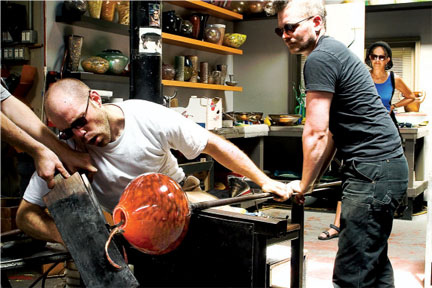Breaking the glass barrier
By Pramod DE SILVA
 Common wisdom is that it is hard to be excited about glass. After
all, it is an object we take for granted, having existed for around
5,000 years. Glass itself is just a material based largely on silica
quartz - we tend to admire various objects made out of it, from drinking
glasses to bottles to vases. Glass is also ubiquitous, from the windows
in our office building to the LCD TV screen at home. Glass has become an
art form too, with glass blowers creating intricate and colourful
designs on glass objects. Common wisdom is that it is hard to be excited about glass. After
all, it is an object we take for granted, having existed for around
5,000 years. Glass itself is just a material based largely on silica
quartz - we tend to admire various objects made out of it, from drinking
glasses to bottles to vases. Glass is also ubiquitous, from the windows
in our office building to the LCD TV screen at home. Glass has become an
art form too, with glass blowers creating intricate and colourful
designs on glass objects.
|

The iconic Philipjohnson Glasshouse |
But glass will not stand still while there are developments in every
other sphere. Although it is hard to think of glass as an area of rapid
technological evolution - “your drinking glass cannot get any better,
right?” it has become one of the key technologies that will bring
incredible innovations over the next few years.
Research
I have been fascinated by glass from my childhood and recently did
some research on the latest advancements in this field. What I found
amazed me, because glass is undergoing a transformation that will make
it virtually unrecognisable in the form you already you know - just
plain glass. Yes, you will be able to bend it, roll it, curve it, get
solar power with it and even get it to clean itself. And that is the tip
of the iceberg. Hundreds of companies, universities and organisations
are working on this glass revolution.
You may not believe this, but the late Steve Jobs was the visionary
who started the modern glass revolution. (And you thought he just made
the iPhone and the iPad). Being a master of outsourcing and supply chain
management, Jobs was looking for a suitable scratch-resistant, tough,
lightweight and durable glass for his first touchscreen iPhone just a
few years ago from an outside supplier. Corning already had a reputation
as one of the most innovative glass companies around, so Jobs called the
Corning CEO and explained what he wanted.
Too late
As it turned out, Jobs was around five decades too late. Corning
already had just the material Jobs wanted, having invented what is now
called Gorilla Glass in the 1960s. At the time, they couldn't find any
commercial applications for it so the project just stopped. Corning
brought the old '60s project back to life and called it Gorilla Glass.
Now, it is the standard for mobile devices and found in 600 million
devices from PCs to tablets to televisions.
Just a couple of months ago, Corning went one better with the
introduction of Gorilla Glass 2, which is astoundingly thin and even
more damage resistant. According to Corning, “Gorilla Glass 2 is as
tough and scratch resistant as ever to withstand the unexpected abuses
of everyday life. But now it's thinner, enabling slimmer and sleeker
devices, brighter images, and greater touch sensitivity”. The Samsung
Galaxy SIII smartphone is one of the latest gadgets to feature Gorilla
Glass 2.
|

Glass blowing is an intricate art |
But Corning, which incidentally has the world’s biggest glass museum
with over 45,000 objects, did not want to rest on its laurels. Its
latest product “Willow Glass” unveiled last week, is even more
astonishing. Willow’s Unique Selling Proposition is its sheer
flexibility - it can be rolled and bent. It is about as thick and
flexible as a piece of paper, while having the strength, durability and
other qualities of existing Gorilla Glass.
Willow Glass can be made as thin as 0.05mm, which is far thinner than
the current 0.2mm or 0.5mm display glass, including Gorilla Glass 2.
Because of its thinness and malleability, Willow Glass could
revolutionise the form and shape of smartphones, TVs, tablets, and other
consumer electronic devices. Handheld devices, for example, will be
thinner and lighter. Dipak Chowdhury, Corning's Willow Glass program
director says some of its uses cannot even be foreseen yet.
Indeed, because it's thin, cost-efficient and lightweight, Willow
Glass could be incorporated in a variety of slim displays, as well as
products that haven't yet been invented. It also has potential
applications in the solar cell and lighting industries. It could be used
for curved displays that can be mounted on non-flat surfaces or for
giving viewers an immersive experience. We could also see new types of
laptops, netbooks or Ultrabooks with flexible screens. ‘Flexibook’,
anyone?
Hermetic seal
Corning says that Willow Glass has the same ability as other types of
glass to provide a hermetic seal for sensitive electronic components,
and it also provides the same touch, feel and other properties of glass.
Corning is currently shipping Willow Glass to designers and
manufacturers for developing new applications.
Moreover, the company had just announced another new (flat)
glass technology that kills bacteria and viruses. This will be great
especially for medical applications.
Although Steve Jobs outsourced the glass for his iPhone, his
fascination with glass meant that Apple also continued research on
glass. The result is Apple ‘Curved Glass’. It will be like Willow, but
on a much bigger scale - for buildings and houses.
This will be seen in Apple’s proposed “spaceship” campus, where there
wouldn't be a single piece of straight glass in the entire building.
Apple is serious about this, having purchased hundreds of
special-purpose machines for the factory manufacturing of
curved-glass displays and construction glass panels. Some say the iPhone
would eventually become a curved-glass device.
Technology
If Apple can get into glasses, why not Google, literally? Google’s
technology involves special glasses which use glass and mirrors to
project a computer display onto one eye, creating the illusion that
relevant information is floating in the air. Wireless connectivity and
artificial intelligence enables you to conjure up facts, see things in
its context, send messages by voice and even take pictures by blinking.
Google's research is moving fast.
And they will also be see-through. Microsoft has developed a display
technology that uses transparent display glass, called the see-through
3D desktop. At present, however, it uses the Microsoft SmartGlass
moniker to refer to a second screen application for the Microsoft Xbox
360 which gives developers the potential to turn smartphones and tablets
into a controller for the Xbox 360.
Universities cannot relax while glass companies and tech companies
steal the limelight – enter the Massachusetts Institute of Technology
with an anti-glare glass. Glass is shiny and causes glare, which makes
screens harder to read in bright light. It also reduces the efficiency
of solar cells. MIT researchers have now solved the glare problem.
The glass has a revolutionary surface pattern made of nano-scale cones
of glass.
Reflection
The new glass is called multifunctional glass. It's very clear,
without glare or reflection. Moreover, the glass also deflects water.
Car windshields using the glass would not (theoretically) need
windshield wipers. Solar cells under multifunctional glass would be
self-cleaning and would enable more light to penetrate through
the glass to the cells. Smartphones, tablets, laptops and TVs would be
essentially self-cleaning.
Talking of solar cells, the US Department of Energy's National
Renewable Energy Laboratory, New Energy Technologies has developed
ultra-thin solar cells that use see-through ‘SolarWindow’ glass. Most of
today’s solar cells are opaque, with minimal efficiency. The technology
could see a commercial launch in a couple of years.
To generate electricity on SolarWindow prototypes, researchers layer
and arrange unique, ultra-thin see-through solar cells on to glass. Each
of these cells is arranged in a network and interconnected by way of a
virtually invisible grid-like wiring system. It is the world's first
technology capable of generating electricity on see-through glass
windows.
There is a lot of research going on for glass.
It is one thing we cannot do without and just a couple of years from
now, we may see glass products we cannot even imagine now. Raise your
glass to technology! |

